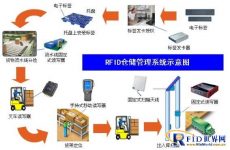
RFID warehouse management application solution
[ad_1]
Warehousing management overview With the popularization of computer applications, most companies’ warehouse management data have begun to use computer database systems for management. However, data is often written on paper and manually entered into a computer to perform collection and statistical recording. This will cause a lot of waste of human resources due to manual data input factors, but also reduce the efficiency of data collection, low accuracy, and often cause errors in sending goods to the wrong destination.

With the continuous development of the scale of most enterprises, the types of materials and other types of materials in the warehouse management business have increased significantly. With the increase in the frequency of warehouses, the work of warehouse management has become very complex and diversified. The traditional manual warehouse operation mode and data collection method have been unable to meet the rapid and accurate requirements of warehouse management. This has seriously affected the operational efficiency of the enterprise, and has become an obstacle restricting the development of the enterprise, so there is an urgent need to establish a warehouse information automation management platform. now,RFIDTechnology provides a simple and easy solution for the warehouse, making our warehouse management smarter?
The development of the Internet of Things technology has given us a beautiful vision. In the future, we will live on a smart earth, a smart city, and enjoy smart medical care, smart transportation, smart warehousing, and smart retail.
Relying on the advantages of RFID technology, relevant companies can change the original warehouse management method, the introduction of RFID technology, focus on the most critical work links in your business, efficiently and accurately complete daily work, eliminate uncertainty, and enable our customers The efficiency of the warehouse can be improved by saving time, reducing inventory, increasing warehouse utilization, and increasing productivity, so that all parts of warehouse management can be automated, intelligent, and modern. We can manage the warehouse in a scientific and intelligent way to increase revenue.
RFID warehouse management application benefits
Radio Frequency Identification (RFID) technology is an important way to automatically identify information and data and enter it into a computer. It provides us with a fast and accurate method for data collection and input. In addition, RFID technology can solve various existing problems through the process of warehouse management and improve the efficiency of warehouse management.
Whether you are a raw material supplier or a retailer who wants to be competitive in the market, you must master the accuracy of inventory to improve efficiency. According to research conducted by industry-related organizations, RFID can increase inventory accuracy from 60% or even lower than the industry average to 95%. If the relevant warehouse management can increase the accuracy to more than 90%, many problems can be effectively solved: the problem of insufficient inventory will be reduced, the throughput and available space of the warehouse will be greatly improved, and it can be grasped in real time Dynamic changes in inventory promote the rise of related interests.
1. Storage
When the goods enter the warehouse through the arrival conveyor belt,ReaderWrite the compressed barcode information of the entire pallet container into the electronic label, and then calculate the shipping location through the computer warehouse management information system, and send the inventory instruction to the forklift vehicle system through the network system, and store it in the corresponding storage location as required.
2. Delivery
After receiving the shipping instruction, the forklift picks up the pallet goods at the designated cargo location. Forklift the front forklift reader to confirm the accuracy of the pallet goods again, and then send the pallet goods to the conveyor belt at the outgoing port, and the conveyor belt reader at the outgoing port reads whether the pallet label information is accurate and verifies that the shipment is correct.
3. Inventory check,
The reader in the warehouse reads the label information of the goods in the warehouse in real time, and checks whether the real-time inventory data is consistent with the warehousing information counted in the database.
4. Cargo area positioning and transfer
The reader in the warehouse reads the label information of the goods in real time, and the control center judges the storage area of each goods according to the reader network, counts the usage of the warehouse, and arranges the storage location of the new incoming goods accordingly.
[ad_2]


